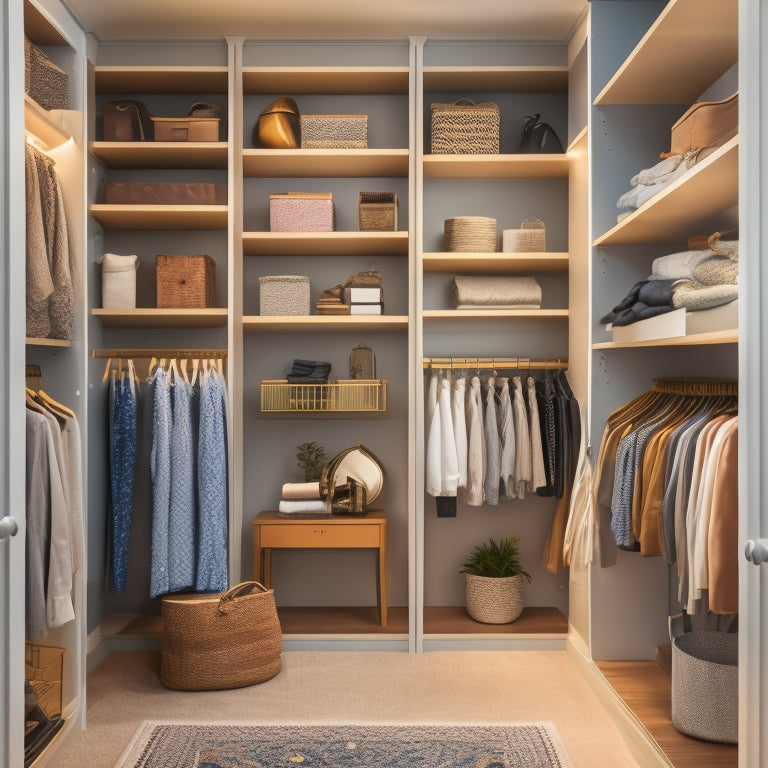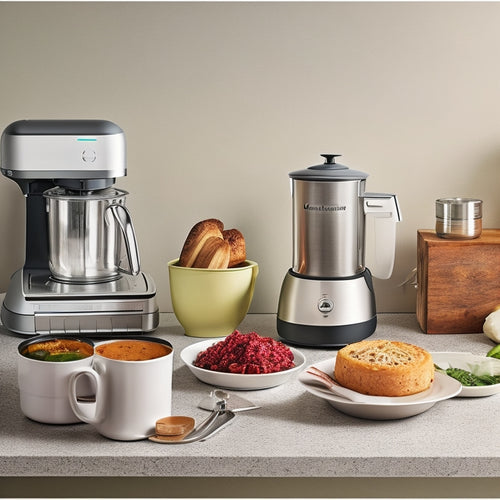
Revamp Your Closets With Expert Organizing Tips
Share
To revamp your closets with expert organizing tips, start by preparing for seasonal changes by categorizing winter items, packing away unused items, and cleaning storage spaces. Mastering closet organization involves understanding closet dimensions, tailoring a system for efficiency, and implementing a color coordination system. Finally, assign a purpose to each storage component, ensuring every item has a designated home, and categorize similar items for efficient organization. By implementing these strategies, you'll be well on your way to optimizing your closet space. Next, discover how to fine-tune your approach to create a tailored organizational system that suits your unique needs.
Key Takeaways
• Categorize winter items into keep, donate, and discard piles to declutter and prepare storage spaces for seasonal change.
• Tailor an organizational system to maximize efficiency and functionality, considering closet dimensions, layout, and personal needs.
• Assign a designated home to each item, using categorization and grouping similar items to maintain a clutter-free space.
• Utilize efficient organization strategies, such as color coordination and frequency-of-use placement, to optimize closet space.
• Implement decluttering strategies and maintain a clutter-free space through purposeful organization and regular maintenance.
Preparing for Seasonal Change
Shifting from one season to another requires a deliberate and systematic approach to closet organization, ensuring a seamless exchange of winter and spring items in storage. This change demands a strategic plan to facilitate efficient switching of clothes and best seasonal storage.
Begin by categorizing winter items into three piles: keep, donate, and discard. Pack away items that are no longer needed, and store them in labeled bins or containers.
Next, focus on preparing storage spaces for the upcoming season by cleaning and dusting shelves, and reinstalling rods or hooks as needed.
Mastering Closet Organization
To master closet organization, it's essential to develop a thorough understanding of the space itself, including its dimensions, layout, and existing storage components, as well as the types and quantities of items to be stored. This understanding will enable you to create a tailored organizational system that maximizes efficiency and functionality.
When designing your closet layout, consider the following key factors:
-
Assess the closet's dimensions and identify areas for improvement
-
Choose a closet layout that accommodates your personal style and preferences
-
Implement a color coordination system to visually organize your belongings
-
Select storage components that cater to your specific needs
-
Consider the frequency of use for each item to determine the best storage placement
Storing With a Purpose
With a well-designed closet layout in place, the next step is to assign a purpose to each storage component, making certain that every item has a designated home and can be easily accessed when needed.
This purposeful organization is key to maintaining a clutter-free space. By implementing decluttering strategies, such as categorizing and grouping similar items, you can maximize your closet's storage capacity.
Efficient space utilization is achieved by selecting storage solutions that cater to your specific needs, such as shelves for folded items, hooks for hanging garments, and bins for accessories.
Frequently Asked Questions
How Do I Keep My Closet Organized When I Have Limited Space?
To optimize limited closet space, utilize space savers like shelves, bins, and baskets, and consider installing a double rod to double hanging capacity, ensuring maximized storage and easy access to your belongings.
What Is the Best Way to Store Out-Of-Season Clothing Items?
As the ancient Greeks stored their togas in cedar chests, so too can you store out-of-season clothing items in vacuum-sealed bags and bins, utilizing vacation storage facilities with climate control to preserve your garments.
Can I Use Baskets and Bins to Store Items in My Closet?
When storing items in your closet, utilize baskets and bins to maximize space and enhance organization. Implement labeling strategies to easily identify contents, and explore aesthetic options to match your personal style, ensuring a cohesive and functional storage solution.
How Often Should I Clean and Maintain My Closet Space?
"As you open your closet door, the familiar chaos greets you. Establish a daily routine of tidying up and schedule a seasonal refresh every 3-4 months to maintain a clutter-free space, ensuring your sanctuary remains organized and peaceful."
Are There Any Closet Organizing Apps That Can Help Me Stay Organized?
Explore virtual assistants and closet organizing apps, such as ClosetMaid or StyleBook, that offer personalized systems to categorize, track, and optimize your closet space, ensuring a tailored approach to maintaining organization and maximizing storage capacity.
Conclusion
To sum up, the art of closet organization is not just a tedious task, but a transformative journey that reveals the very essence of one's being.
By embracing the expert tips and strategies outlined above, individuals can transcend the chaos of cluttered closets and access a domain of unprecedented productivity, serenity, and control.
As the seasons change, so too can the trajectory of one's life, with a well-organized closet serving as the catalyst for a more streamlined, efficient, and extraordinary existence.
Related Posts
-

What's Missing in Your Storage Space Solution?
You're likely overlooking hidden opportunities to optimize your kitchen's storage capacity, leading to inefficiencies...
-

What Are the Best Compact Smart Kitchen Appliances?
When it comes to compact smart kitchen appliances, you'll want to prioritize energy efficiency, space-saving design, ...

